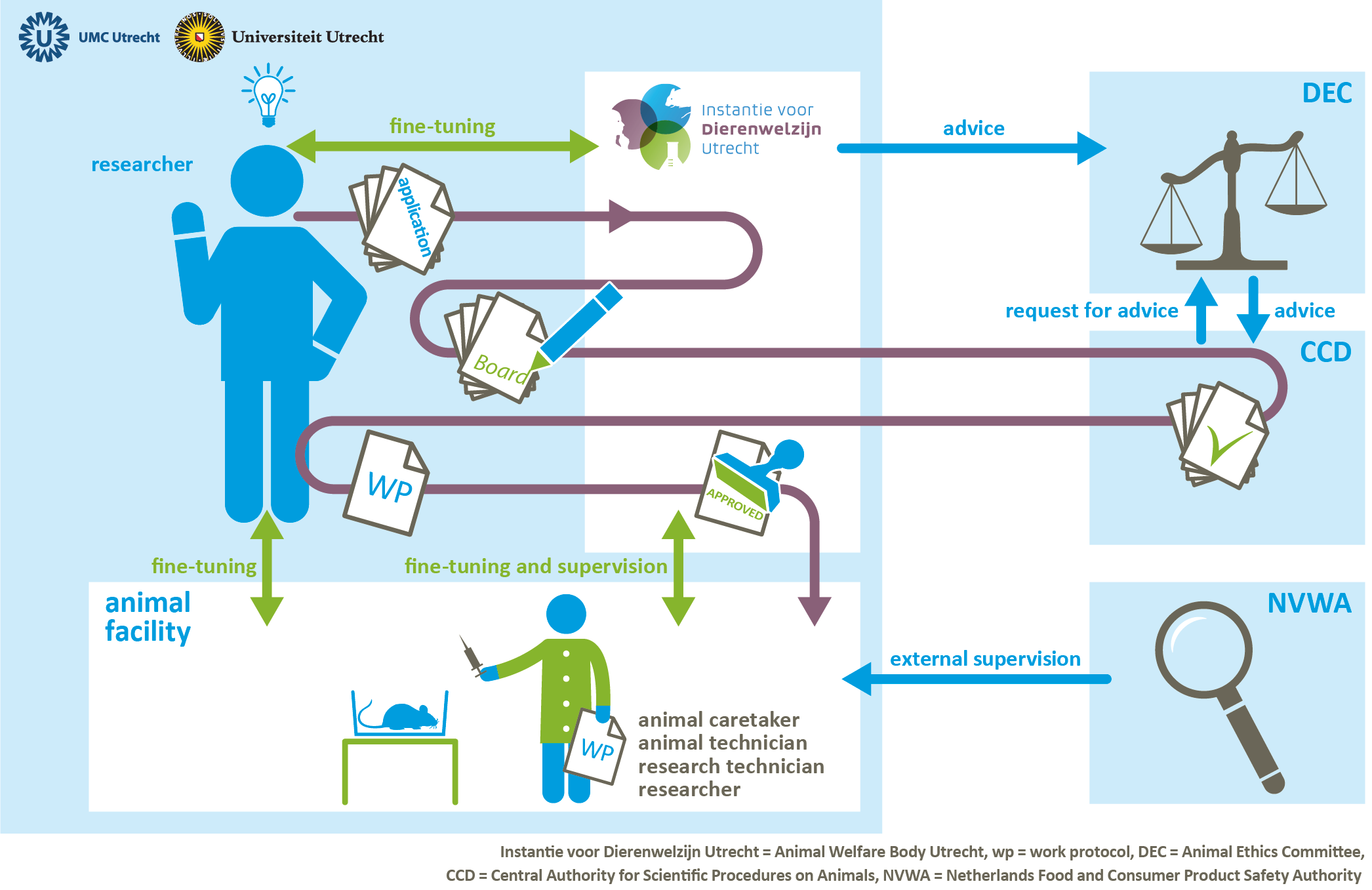Annual Report on Animal Experiments
English summary
This is the English summary of the 2022 Annual Report on Animal Experiments by Utrecht University and the University Medical Center Utrecht (UMC Utrecht). It provides information about the use of laboratory animals by the two institutions.
This publication was prompted in part by the Dutch Code for Transparency in Animal Testing. It is one of the many tools we use for being transparent about experiments on animals. For example, there are the very informative websites of the Animal Welfare Body Utrecht, the Animal Ethics Committee Utrecht and the 3Rs Centre Utrecht.
Accountability
At Utrecht University and UMC Utrecht, research in the life sciences (both veterinary and medical-biological) is carried out. Animal experiments are conducted in addition to experiments based on, for example, cell and tissue culture techniques, computer simulations and experiments on human volunteers. Laboratory animals are also used for education and training. All animal use is performed with great care, under supervision of the Utrecht Animal Welfare Body.
Not, unless...
The Dutch Experiments on Animals Act (2014) stipulates that animal experiments may only be carried out if there is really no other option ("not, unless..."). That is, only if there is no animal-free way to achieve the same goal (Replacement). The point of departure is that animals can experience positive and negative emotions and have an intrinsic value. If animal use is inevitable, it is mandatory to see whether that animal experiment can be improved with respect to Reduction of the number of animals and Refinement by, for example, improvement of housing, supervision and procedures. This rule has been elaborated into a set of requirements and steps to take.
From idea to animal experiment

Figures
The number of laboratory animals does not equal the number of animal experiments, since on the one hand animals have been re-used in other experiments, and on the other hand animals were bred as laboratory animals without being used in experiments. Both numbers are kept as low as possible and have decreased slightly last year.
Number of animal experiments

Purpose
40% of the animal experiments were conducted for fundamental research: research into processes, such as research into the functioning of organs. In fundamental research, the way research outcomes will be applied is not yet clear. 48% was conducted for applied research and translational research. Applied research is research that is directly aimed at an application, for example a specific medical therapy. Translational research connects fundamental and applied research, and often includes translation from results of animal research to clinical application for humans. Finally, laboratory animals are used in education and training, for example in veterinary and laboratory animal science courses. This was the purpose of 10%. About 2% related to breeding of animals with a harmful phenotype.
Animal species
For each research project, the most suitable animal species is used. About half of the experiments are conducted with mice. In addition to mice, rats and chickens were also frequently. Other animals used in experiments and education are zebrafish, pigs, birds (other than chickens), cattle, sheep, horses, rabbits and guinea pigs.
Discomfort
Discomfort is the legal term for all negative experiences that laboratory animals experience through animal experiments. It is mandatory to classify discomfort into the categories of mild, moderate and severe discomfort, or non-recovery (the animal dies during anesthesia having had no previous discomfort). A permanent effort is being made to keep discomfort levels as low as possible.
Mild: 58%
Moderate: 36%
Severe: 4%
Non-recovery: 2%
Rehoming
In mid-2019, a pilot was started in collaboration with animal welfare organizations to explore the options of rehoming rodents in a responsible manner, taking into account the safety, welfare and health of humans and animals. Most of the redundant rodents are bred as laboratory animals, but have not actually been used for animal testing. Genetically modified animals are excluded on grounds of legislation. The pilot was worked out positive. During 2022, 63 mice and 207 rats and 131 animals from other species found a new home.
Trend in the number of animal experiments
Over the period 2001-2022, the number of animal tests performed by Utrecht University and UMC Utrecht decreased from 51,900 to 20,436. Especially in the period 2010-2014, there was a considerable decrease in the number of animal experiments. Now that ‘quick wins’ in Replacement and Reduction of animal experiments are being applied, the decline is flattening out. However, the figures of recent years and hence the trend in recent years are also more difficult to interpret due to stagnation and catch-up activities in research and education as a result of the corona epidemic.

Utrecht University
Trend killed without being used
The number of laboratory animals killed without being used in experiments, like excess breeding animals, has been steadily decreasing since 2015, from 27,690 to 6160 in 2022.

Utrecht University


 English summary
English summary